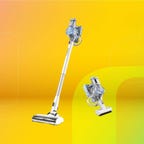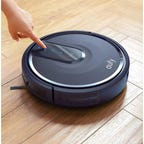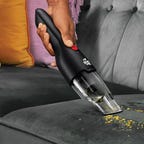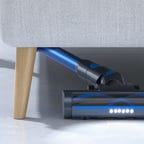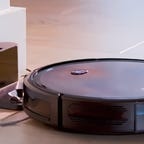Best Cheap Vacuums for 2024
We tested dozens of vacuums and picked the best cheap models to help you clean house on a budget.
What to consider
Vacuum type
Cost and value
Floor type
Our Picks
What's the best cheap vacuum?
Cleaning the flooring in your home is not generally considered a fun task, and it gets worse when the products needed to get the job done are expensive. Not to fear -- we've tested a wide range of robot vacuums and cordless stick vacs at every price and have recommendations for models that will get your floors in tip-top shape without burning through your wallet. Topping our list of the best cheap vacuums is the Tineco A11 stick vac. This high-performance cordless vacuum is the cheapest model on our list of best vacuums, so it's only natural for it to appear atop our list of budget-friendly vacuum cleaners.
However, there are more than just stick vacs that help clean your floors. If you prefer something a bit more hands-off, then you'll want one of the best robot vacs for cheap. In that category, we chose the Eufy RoboVac 25C, which can be had for as low as $150 when you find it on sale. This helpful robot is another one that makes its way onto our overall best vacuum list and impressed us with consistent and thorough cleaning across many floor types. But we have even more picks for cheap vacs for every type of budget-conscious homemaker, and we'll continue to update this list as new contenders pass through our testing facility.
Best cheap vacuum cleaners for 2024
As a top performer in our current cordless vacuum test group, the Tineco A11 stick vacuum represents an outstanding deal -- especially right now, as it sports an $80 coupon at Amazon, bringing it down to $210. In fact, we think so highly of this cordless vacuum that it also appears on our full list of best vacuum cleaners.
When it comes to cleaning up pet hair, barely a trace of the material remained after the machine vacuumed mid-pile carpeting and hardwood floors. Some strands were left visible when traveling across our low-pile test carpet. Mid-pile carpeting usually causes more problems for vacuums, but the Tineco's A11’s solid battery life delivers up to 35 minutes of uninterrupted run time.
The A11 series design looks nice and is functional, with a dustbin that's easy to completely empty. There's also a handy trigger lock lever to keep the vacuum running without constant finger pressure. The Tineco A11 ships with some helpful accessories, including a power brush, a mini power brush, a two-in-one dusting brush, and a crevice tool for versatile cleaning.
Best overall cheap robot vacuum
Eufy RoboVac 25C
While "you get what you pay for" is frequently true, with the Anker Eufy RoboVac 25C, the low price doesn’t tell the entire story. In our testing of this device, we found it performs very well, putting up scores that aren’t too far off from more expensive models. For instance, its ability to scour sand from hardwood floors (78.9%) wasn't too far below that of the
Best cheap handheld vacuum
Dirt Devil Grab & Go Plus
Dirt Devil’s Grab & Go Plus is very compact and has a comfortable design that makes it easy to hold while cleaning up small messes around the house, car, office, or wherever else you need to make a quick clean-up. However, don’t let this handheld vac’s diminutive size and low price fool you. It is far more capable than either of those factors might lead you to believe.
We put all 75 watts of cleaning power to work in our tests, with an overall average score of 68.3% picking up sand from our test surfaces (95.6% on hardwood, 53.6% on the low-pile carpet, and 55.8% on the mid-pile carpet.) As for sucking up the larger black rice grains from those surfaces, the Grab & Go Plus averaged 99.1% overall. It snagged 98.9% from the hardwood floor, 99.4% from low-pile carpet and 99.1% from mid-pile carpet -- all for $40.
The Dirt Devil Grab & Go Plus includes a two-in-one dusting brush and crevice tool to help you get into smaller spaces, as well as a charging stand to keep your vacuum charged and ready to go. The biggest drawback to the Grab & Go Plus is that it can be a bit on the noisy side. So keep that in mind when cleaning up a mess while others may be sleeping or watching a movie.
Best cordless vacuum under $100
Lubluelu 009
At a very budget-friendly $70, the Lubluelu 009 is an easy recommendation for those looking to save some cash and still get some cleaning done without dragging around a cord.
The stick vac did a commendable job by picking up 96% (on average) of our test sand from hardwood. On low-pile carpets, that figure dropped to a very respectable 66.7%. The Lubluelu 009 even fared well cleaning up the thicker mid-pile carpet, earning a higher sand pickup average of 59.2%.
Black rice, our large-particle test soil, was no trouble for the Lubluelu vacuum. It managed a pickup rate of above 96% on hardwood and well above average on low- and mid-pile carpets (100% and 98%, respectively).
For pet owners or those who share a home with a long-haired human, the V-shaped brush design does a good job of avoiding tangles. But the Lubluelu 009 did have some issues getting all the pet dander from the carpets.
Best robot vacuum under $100
Ionvac SmartClean 2000
Want a good robot vacuum for under $100? Walmart is selling the Ionvac SmartClean 200 for only $70. This is a solid option if you are on a tight budget and have mostly hard flooring surfaces.
In our testing, the SmartClean 2000 cleaned up over 87% of the black rice from hardwood floors and nearly 79% of the sand. The scores for getting the rice from low- and mid-pile carpets were even better, hitting 97% and 98%, respectively. However, the scores dipped quite a bit when it came to getting the sand out of the carpets, with only 25% getting sucked out of the low-pile and almost 33% from the mid-pile.
Ionvac’s SmartClean 2000 uses the same navigation style as the Eufy Robovac 25C by simply driving until it runs into an object and then redirecting itself to the next open area. But at $70, that’s a tolerable situation. Along with app control, the SmartClean 2000 also ships with a physical remote to control the device and choose from the different cleaning modes.
Factors to consider when buying a vacuum cleaner
Vacuum type: Robot vs. cordless stick
We've tested dozens of stick vacs to find the best cheap models available.
Long gone are the days when there were only big, heavy corded vacuums to choose from when it came time to clean up the floors in your home. Now, there is a wide range of options with just as wide of a price range. Choosing which vacuum cleaner type is best for you can be narrowed down to two key points: How much physical effort do you want to put into cleaning? What kind of flooring does your home have?
If you want to take as much of the manual labor as possible out of the equation, you'd opt for a robot vacuum. However, if your home has stairs or narrow spaces, picking up an excellent cordless vacuum could be better for you. Sure, you'll be required to maneuver it around your home -- but these options are lightweight and provide the flexibility to reach those areas that a robot vacuum can't. Plus, you won't have to worry about it getting stuck or dealing with an app.
Depending on the type of flooring you have in your home, a device that can adapt to both hard flooring and carpets, like a robot vacuum, may offer a more complete cleaning experience. Regarding the type of carpet, there are times when using my cordless vacuum on one of my rugs that it will sort of skip across the carpet and not really suck up much of the debris due to the lightweight cleaning head.
Cost and value
Robot vacs have become far more affordable in 2024.
Considering you're looking at a list of the best cheap vacuum cleaners, this factor is likely very important to you. (And it's something that is or should be considered, regardless of what you're purchasing.) Nobody likes to waste their money, and getting the best bang for your buck is essential when you're on a tight budget. What a good vacuum cleaner can do is save you time. By picking the correct tool for the job and getting one great at its purpose, you'll spend less time cleaning and more time doing what you enjoy.
Generally speaking, a robot vacuum will typically cost you more money than a stick vac. This is largely due to the additional sensors and technologies within the robot in order for it to operate properly. However, if your home is set up to handle a great robot vacuum just as well as a stick vac and the price is similar, then the question turns to: Which will save you more time?
Here is where value comes into play. Something might cost you more, but providing the intangible things offsets the additional cost. So, at the same (or similar) prices, a robot vacuum can relieve you of the duty of physically sweeping your floors.
Floor type
Some vacs do better on hardwood while others clean rugs and carpets with more proficiency.
You probably read many mentions of different floor types when you are considering either a robot or stick vacuum. Not all flooring is the same, and neither is the cleaning ability for each vacuum. If you have primarily hard surfaces throughout your home, you'll likely be good to go with a stick or robot vacuum. The question you need to answer then is whether you want an automated cleaner or if you want to be hands-on with it.
Should your home have more carpets and rugs than hard floors, you'll want to consider which kind of dirt your home may encounter more — finer debris or larger. Then also consider whether the soft surfaces are low-pile, mid-pile, or high-pile, as these come into play when it comes to vacuum style effectiveness. We include in our testing results all of these considerations when recommending vacuums.
How we test vacuum cleaners at CNET
We test all vacuums on both hardwood flooring and carpet.
How we test robot vacuums
Our method for evaluating robot vacuums is straightforward, yet grueling. There are two types of tests we run. The first trial is to figure out how well a robot covers the floor while it's cleaning. We built an industry-standard testing room as specified by the International Electrotechnical Commission just for this purpose. The IEC is an international standards body responsible for managing robot vacuum testing procedures, among other things, for vacuum manufacturers.
Say hello to our robot vacuum test room. Inside it are objects that might look a little odd. They're design to simulate furniture and obstacles a robot will encounter in the real world.
Inside this room are objects designed to simulate typical obstacles a robot vac encounters for navigation as it cleans. These obstacles include wall edges, table and chair legs, couches and other furniture, and so on, plus bare tile and hardwood floors, as well as carpet. We mount LED lights to the top of each vacuum cleaner. The dimensions of the lights correspond to the measured nozzle width of each particular robot vacuum we test.
As robots move through the room while cleaning, an overhead camera captures a long-exposure image of the entire room in low light. That photo will then have a light trail, created by the LEDs, that shows the exact areas where the robot traveled (and its nozzle position) during its runtime. We can also see areas of the floor where the vacuum may have missed or gotten stuck. You can see the navigation results of all the robot vacuums in our test group in the gallery below.
The second type of test reveals exactly how much physical debris a vacuum is able to pick up off of the floor. To mimic dirt of small particle size, we use a mixture of play sand and landscaping sand. For bigger particle soil, we use grains of uncooked black rice. Robots then run in straight line mode across three types of flooring (low-pile carpet, medium-pile carpet and hardwood bare floors).
More of our robot vacuum testing setup.
We control for the specific nozzle width of each vacuum, too. We constructed an adjustable tool to soil our test floors. It lets us lay down a strip of a precise area of soil to match the nozzle dimensions for every robot. The mass of soil isn't chosen at random either. We measure a proportional amount that's related to the flooring material, type of debris, plus each vacuum's nozzle width.
We conduct three cleaning runs (at minimum) on each floor type. We also perform cleaning tests with sand and rice separately. That comes to at least 18 tests per robot vac. We weigh the robot's dust bin both before and after each run. From there we can calculate the percentage of debris pickup for every cleaning run and the average amount of soil a machine manages to remove. Additionally we run anecdotal (visual) pet hair tests for each robot, on all three floor types.
Our rice-based, medium-size particle test didn't show enough differentiation between each cleaner, which says they can all handle larger particles without trouble. For fur removal for pet owners, we judged anecdotally.
How we test cordless vacuums
We run tests in a straight line across all three floor types.
Putting cordless vacuums through their paces isn't as complicated as testing a robot vacuum cleaner, but it still takes lots of time and careful effort to find the best cordless vacuum. We run each vacuum in a straight line across three different surfaces (hardwood, low-pile carpet, midpile carpet). On all three test beds, the test area is the same length (30.25 inches).
We tested a vacuum's ability to clean up sand and rice.
Just like in robot tests, the width of the test bed is proportional to the vacuum's nozzle width. We measure this width ourselves. We also use nozzle width, plus the flooring type, to calculate the soil density for each test, per IEC guidelines. We use the same soil types here as well; sand, rice and pet hair. We perform three runs (at minimum) on each floor type. We also test suction power with sand and rice separately. That comes to at least 18 tests per vacuum. We weigh the vacuum's dust bin both before and after each run.
From there we can calculate the percentage of dirt and debris pickup for every run and the average amount of soil a vacuum manages to remove. Additionally, we run anecdotal (visual) pet hair tests for each vacuum, on all three floor types to help us select the best cordless vacuum.
Cheap Vacuum FAQs
How much should you pay for a vacuum cleaner?
If you're looking for a high-performance vacuum that will maintain its battery life and last for several years, you'll have to pay around $400 for a robot vacuum and $300. That said, if you're on a tighter budget there are serviceable options for much less. Many of the vacuums on this list performed well in one-off testing but how long they will keep their form is another question. Cheaper vacuums may have a shorter overall life than a pricier model from the likes of Dyson or Samsung.
Which vacuums have the strongest suction?
Suction power for robot vacuums and stick vacs is calculated differently, making it challenging to compare head-to-head. However, you can use each type of measuring method to help inform you how much suction each style of cleaning tool offers. Robot vacuums use units of pascal or "Pa" to indicate the suction power for these devices, with the average being between 25010 and 3000 Pa.
For stick vacs, the standard unit of measurement is air watts, or "AW," to give consumers an idea of the vacuum's suction power. AW combines water lift and airflow methodologies and is recognized by the American Society of Testing and Materials.
What is the most reliable vacuum cleaner?
Each vacuum style can offer long-term cleaning ability should you properly maintain your machine. This includes removing clogs and periodically giving the vacuum a deep clean. Generally, especially for cheap stick vacs, fewer things can go wrong and cause the unit to become less reliable. Robot vacuums rely on sensors and more moving parts to properly clean your floors. Then there's an app and other software aspect that can sometimes cause issues. This is not common, but it is something to be aware of.


